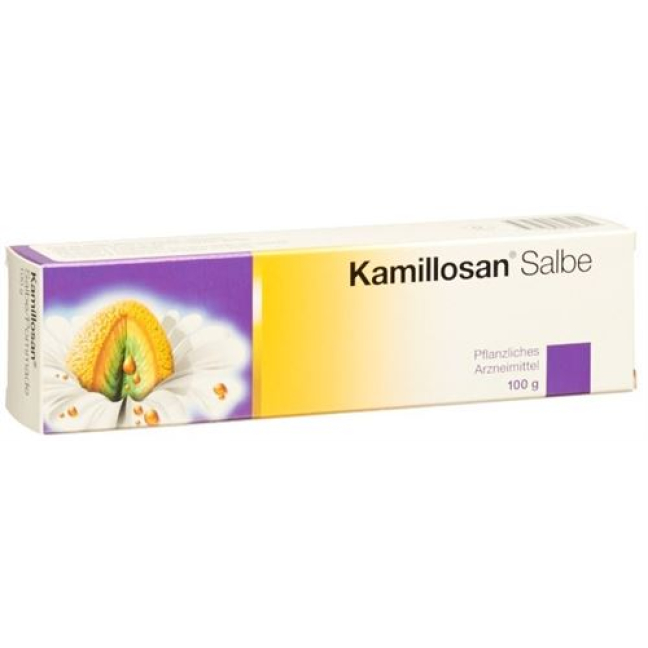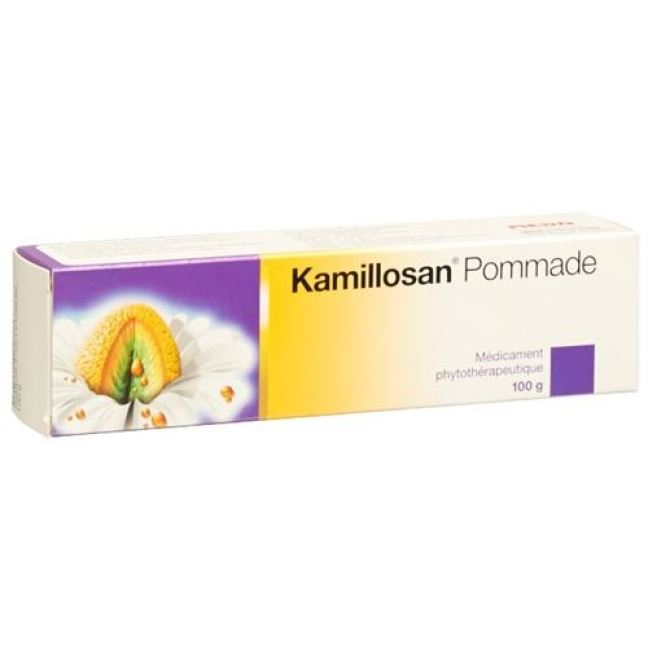Kamillosan ointment 100 g
Kamillosan Salbe 100 g
-
47.42 USD

- Availability: Outstock
- Brand: MYLAN PHARMA GMBH
- Product Code: 1563165
- ATC-code D03AX99
- EAN 7680525620315
Ingredient:
Description
The chamomile flower is characterized by anti-inflammatory, pain-relieving, itching-relieving, slightly disinfecting, calming and odor-eliminating properties.
Kamillosan ointment contains a dry extract of chamomile blossoms, so Kamillosan ointment can be used for: abrasions, scratches and lacerations, cracks, cracked skin on the hands or the corners of the mouth. Also for inflammatory skin symptoms, itching (especially in dry, low-fat skin), abscesses and boils.
Kamillosan ointment heals the nipples during pregnancy and lactation.
In baby care, Kamillosan ointment helps against soreness and other irritations of the skin.
Due to its properties, Kamillosan ointment is particularly suitable for the treatment of dry skin damage.
Swissmedic-approved patient information
Kamillosan® ointment, ointment
Herbal medicinal product
What is Kamillosan ointment and when is it used?
The chamomile flower is characterized by anti-inflammatory, pain-relieving, itching-relieving, slightly disinfecting, soothing and odor-eliminating properties.
Kamillosan ointment contains a dry extract of chamomile blossoms, so Kamillosan ointment can be used for: abrasions, scratches and lacerations, cracks, cracked skin on the hands or the corners of the mouth. Also for inflammatory skin symptoms, itching (especially in dry, low-fat skin), abscesses and boils.
Kamillosan ointment heals the nipples during pregnancy and lactation.
In baby care, Kamillosan ointment helps against soreness and other irritations of the skin.
Due to its properties, Kamillosan ointment is particularly suitable for the treatment of dry skin damage.
What should be considered?
If there is no improvement within 3 days or even fever occurs and in the case of symptoms of a bacterial infection (e.g. suppurating skin damage), is to consult a doctor or nurse.
Before breastfeeding newborns, the mother must remove the ointment in the area of her nipples.
Wool fatty alcohols and butylated hydroxytoluene can cause local skin reactions (contact dermatitis). Butylated hydroxytoluene can also cause irritation to the eyes and mucous membranes. Kamillosan ointment must not be used in the eye area.
If Kamillosan ointment is used to treat the genital or anal region and latex condoms are used at the same time, their tear resistance can be reduced by the ingredient paraffin (Vaseline) and their protective effect can be impaired as a result.
When should Kamillosan ointment not be used or only with caution?
If you are hypersensitive to one of the ingredients, Kamillosan ointment should not be used.
In the case of hypersensitivity to other daisy family (Asteraceae) such as Achillea millefolilum (sheep gift), Arnica montana (arnica), mugwort, Bellis perennis (daisy), Calendula officinalis (marigold), chrysanthemum, echinacea (coneflower), daisies allergic cross-reactions (see under «What side effects can Kamillosan ointment have?»)
The ointment should not be used on newborns (infants up to 1 month old).
For further precautionary measures, see «What should be considered?».
Inform your doctor, pharmacist or druggist if you suffer from other illnesses, have allergies or are taking other medicines (including those you bought yourself) or using them externally!
How do you use Kamillosan ointment?
Infants from 1 month
A pea-sized ointment up to 3 times a day as needed Apply a piece of ointment to the affected area of skin and massage in gently
Children from 1 year and adults
As needed, apply a pea- to nut-sized piece of ointment to the affected area of skin up to 5 times a day and massage in gently.
Follow the dosage given in this leaflet or as prescribed by your doctor. If you think the medicine is too weak or too strong, talk to your doctor, pharmacist or druggist.
What side effects can Kamillosan ointment have?
Frequency not known:
- Hypersensitivity reactions to chamomile (e.g. contact dermatitis)
- Cross-reactions (allergic reactions) in people with hypersensitivity to other composite plants such as auricula, arnica, mugwort, daisy, calendula, coneflower, chrysanthemum, Daisies or hypersensitivity to the ingredients of the ointment base (see also under "When should Kamillosan ointment not be used or only with caution?")
- Severe allergic reactions with shortness of breath, facial swelling, circulatory collapse and anaphylactic shock after contact with mucous membranes, especially in cases of improper use of liquid chamomile preparations.
In these cases, the treatment should be discontinued and, if necessary, a doctor should be consulted.
If you notice any side effects that are not described here, you should inform your doctor or pharmacist.
What else needs to be considered?
Keep Kamillosan ointment in a place that is inaccessible to children. Store at room temperature (15-25°C). The medicinal product may only be used up to the date marked “EXP” on the package.
Your doctor, pharmacist or druggist can provide you with further information.
What does Kamillosan ointment contain?
1 g Kamillosan ointment contains: 3.9-4.7 mg dry extract of chamomile flower (drug-extract ratio = DEV: 10.3-14.3:1) corresponding to at least 0.07 mg Levomenol. Extraction agent ethanol 96% (v/v), water, sodium acetate, sodium hydroxide.
This preparation also contains wool wax, flavorings (ethyl vanillin and others) and other additives.
Approval number
52562 (Swissmedic).
Where can you get Kamillosan ointment? What packs are available?
Kamillosan ointment is available in pharmacies or drugstores without a doctor's prescription.
Packs of 40g and 100g are available.
Authorization holder
MEDA Pharma GmbH, 8602 Wangen-Brüttisellen.
This leaflet was last checked by the drug authority (Swissmedic) in September 2018.





